Miphams Beacon of Certainty
Studies in Indian and Tibetan Buddhism
THIS SERIES WAS CONCEIVED to provide a forum for publishing outstanding new contributions to scholarship on Indian and Tibetan Buddhism and also to make accessible seminal research not widely known outside a narrow specialist audience, including translations of appropriate monographs and collections of articles from other languages. The series strives to shed light on the Indic Buddhist traditions by exposing them to historical-critical inquiry, illuminating through contextualization and analysis these traditions unique heritage and the significance of their contribution to the worlds religious and philosophical achievements.
Members of the Editorial Board:
Tom Tillemans (chair), University of Lausanne
Jos Cabezn, University of California, Santa Barbara
Georges Dreyfus, Williams College, Massachusetts
Janet Gyatso, Harvard University
Paul Harrison
Toni Huber, Humboldt University, Berlin
Shoryu Katsura, Ryukoku University, Kyoto
Thupten Jinpa Langri, Institute of Tibetan Classics, Montreal
Frank Reynolds, Emeritus, University of Chicago
E. Gene Smith, Tibetan Buddhist Resource Center, New York
Cristina Scherrer-Schaub, University of Lausanne
Ernst Steinkellner, University of Vienna
Leonard van der Kuijp, Harvard University

Wisdom Publications
199 Elm Street
Somerville MA 02144 USA
1999 John Whitney Pettit II
All Rights Reserved.
No part of this book may be reproduced in any form or by any means, electronic or mechanical, including photography, recording, or by any information storage and retrieval system or technologies now known or later developed, without permission in writing from the publisher.
Library of Congress Cataloging-in-Publication Data
Pettit, John W. (John Whitney)
Miphams beacon of certainty : illuminating the view of Dzogchen,
the Great Perfection / by John W. Pettit.
p. cm.
Includes bibliographical references and index.
ISBN 0-86171-157-2 (alk. paper)
ISBN 978-0-86171-719-4 (ebook)
1. Rdzogs-chen (Ri-ma-pa) 2. Ri-ma-pa (Sect)Doctrines I. Mi-pham-rgya-mtsho, Jam-mgon Ju, 18461912. es es rin po chei sgron me. English. II. Title. III. Series
BQ7662.4.P456 1999
294.34dc21 99-33810
ISBN 0-86171-157-2
12 11 10 09 08
6 5 4 3
Cover Design by Gopa & the Bear
Interior by Gopa
Wisdom Publications books are printed on acid-free paper and meet the guidelines for the permanence and durability of the Production Guidelines for Book Longevity of the Council on Library Resources.
Printed in the United States of America
 This book was produced with environmental mindfulness. We have elected to print this title on 50% PCW recycled paper. As a result, we have saved the following resources: 27 trees, 19 million BTUs of energy, 2,376 lbs. of greenhouse gases, 9,861 gallons of water, and 1,266 lbs. of solid waste. For more information, please visit our website, www.wisdompubs.org
This book was produced with environmental mindfulness. We have elected to print this title on 50% PCW recycled paper. As a result, we have saved the following resources: 27 trees, 19 million BTUs of energy, 2,376 lbs. of greenhouse gases, 9,861 gallons of water, and 1,266 lbs. of solid waste. For more information, please visit our website, www.wisdompubs.org
Table of Contents
His Holiness Penor Rinpoche
L AMA MIPHAM was a great Nyingma scholar of the nineteenth century who wrote a prodigious number of works on all subjects, including numerous brilliant commentaries on both stra and tantra. His work translated here by John Whitney Pettit as the Beacon of Certainty is particularly famous and is one of the most beneficial for clearing away confusion and doubt regarding views, paths, and meditation.
It is my earnest hope that John Pettits translation will bring great benefit to foreign students and scholars in the study of both philosophy and meditation practice.
This work is valuable indeed. I pray that all sentient beings may benefit from this text and ultimately attain enlightenment.

Drubwang Pema Norbu
Publishers Acknowledgment
THE PUBLISHER gratefully acknowledges the generous help of the Hershey Family Foundation in sponsoring the publication of this book.
I MUST FIRST DEDICATE the merit of this work to my parents, Jack and Anne Pettit, whose unfailing support, both emotional and financial, has made it all possible; and to my wife, Victoria, for keeping faith in my ability to finish this seemingly interminable project.
For empowering blessings textual transmissions, elegant explanations, and personal guidance, there is no way to repay the kindness of my root teacher, the late Dilgo Khyentse Rinpoche. He was a peerless master of the scriptures and realizations of stra and tantra, and a nonsectarian holder of all the lineages of Tibetan Buddhism. Khyentse Rinpoche dedicated his life to preserving Buddhist traditions, saving many of them from oblivion. He collected, edited, and published many volumes of rare texts, and restored dozens of Tibetan temples and monasteries destroyed during the Cultural Revolution. Khyentse Rinpoches own teachers, and the many great scholars and yogis among his colleagues and disciples, knew him as the manifestation of the wisdom mind of Majur, as the unobstructed voice of countless Indian and Tibetan siddhas, and as the bodily rebirth of the nineteenth-century master Jam dbyangs mKhyen brtse dbang po. There is no doubt that he was a brilliant moon (rab bsal zla ba) in the starry sky of the paitas and siddhas of India and Tibet; that in accomplishing the benefit of self and others, he was endowed with a brilliant wealth of auspiciousness (bkra shis dpal byor); and that, by realizing and transmitting the Great Perfection teachings, he raised the victory banner of the teaching of the changeless supreme vehicle (gyur med theg mchog bstan pai rgyal mtshan) in many countries around the world.
As an infant, Khyentse Rinpoche received blessings and prophecies of future greatness from Mipham Rinpoche, who conferred upon him the name bKra shis dpal byor (Mangalarbhti). As the heart disciple of Miphams main student Zhe chen rgyal tshab Pad ma rnam rgyal, Khyentse Rinpoche was a principle heir to Miphams teachings. I was extremely fortunate to receive teachings from Khyentse Rinpoche in the years 19851990, including a precious few teachings of Miphams tradition. In one of my first meetings with him, Rinpoche encouraged me to combine study and practice. I believe it is only due to Khyentse Rinpoches constant inspiration that I have been able to digest a small portion of Miphams writingsnot merely as an intellectual challenge, but as a key for opening a door to the living teachings of the Buddha.
In this very preliminary exploration I can hardly hope to have done justice to the profound and vast wisdom of masters such as Mipham and Khyentse Rinpoche, so for the distortions and omissions that my efforts will undoubtedly evince, I beg the pardon of the enlightened beings. It is my fervent wish that the efforts of other scholars will improve upon my own, and that the Nyingma and other traditions of Buddhadharma will spread and develop, benefitting countless beings.
I must also express boundless gratitude for the guidance and support of these excellent spiritual teachers and friends, whose wisdom and compassion have never failed to inspire: H.H. the Dalai Lama, H.H. Penor Rinpoche, Kyabje Trulshik Rinpoche, Tulku Pema Wangyal, Nyoshul Khen Rinpoche, Tulku Thondup, H.H. Sakya Trizin, Kyabje Thinley Norbu Rinpoche, Lama Tharchin Rinpoche, Khenpo Palden Sherab, Khenpo Tsewang Dongyal, Dzongsar Khyentse Rinpoche, Tulku Jigme Khyentse, Shechen Rabjam Rinpoche, Bhakha Tulku, Urgyen Thinley Rinpoche, Tulku Thupten, Lama Pema Wangdak, and Mathieu Ricard. In particular, I must acknowledge Khensur Lobsang Tharchin, who introduced me to the teachings of Je Tsong kha pa, and Gyalse Tulku, who conferred the reading transmission
Next page

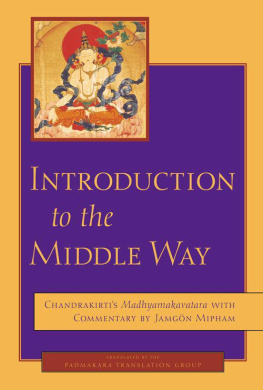
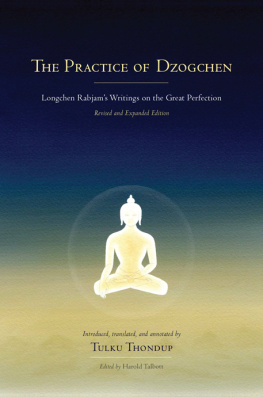
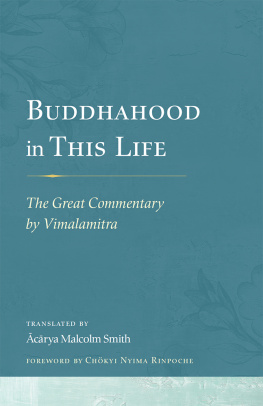

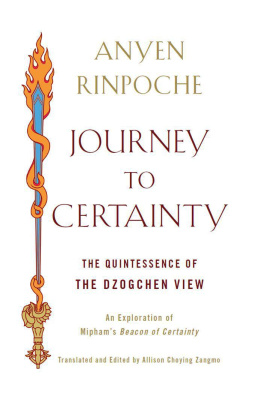
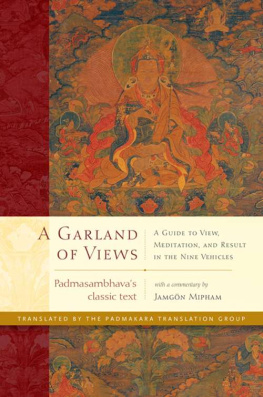
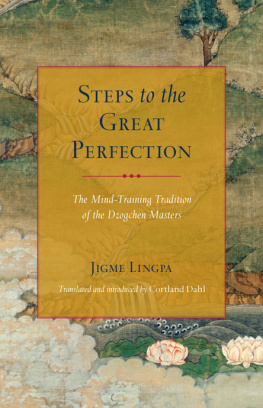
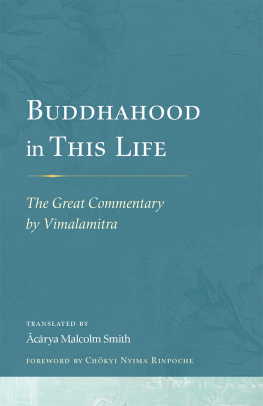

 This book was produced with environmental mindfulness. We have elected to print this title on 50% PCW recycled paper. As a result, we have saved the following resources: 27 trees, 19 million BTUs of energy, 2,376 lbs. of greenhouse gases, 9,861 gallons of water, and 1,266 lbs. of solid waste. For more information, please visit our website, www.wisdompubs.org
This book was produced with environmental mindfulness. We have elected to print this title on 50% PCW recycled paper. As a result, we have saved the following resources: 27 trees, 19 million BTUs of energy, 2,376 lbs. of greenhouse gases, 9,861 gallons of water, and 1,266 lbs. of solid waste. For more information, please visit our website, www.wisdompubs.org